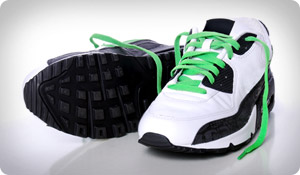
Walking is the most natural exercise on earth but the right shoe can make your efforts go further and even help prevent injury. But with so many options available, how do you know which pair buy? Don't worry: We've got your walking shoe primer right here.
Think of what you're asking your feet to do when you head out the door or up the trail. Each step means your feet, ankles, leg bones, muscles and knees have to interact in very specific ways to make smooth steps, maintain your balance, absorb impact and support your weight. If your shoe is worn out, doesn't fit properly and doesn't support you, you may experience painful blisters, calluses, bunions, joint and tendon injury, shin splints, pressure fractures, tendonitis, plantar fasciitis and more. If you invest in a good, supportive, and well-structured walking shoe, however, your feet will carry you for mile after painless mile.
Picking the right walking shoes comes down to three words: Fit, arch, and stability. Shop at an athletic shoe store with professional fitters. In addition to comfort and fit, they'll help you determine which brands are best for your individual foot type and gait.
Fit. Have your feet professionally measured every time you shop for shoes. Gravity, weight, and fluid retention causing your foot size to fluctuate throughout the day and throughout your lifetime. The best time to have them measured is late afternoon when they're at their largest.
- Go for a short walk immediately before you go to the shoe store so they'll be at their "walking size."
- Wear the socks you'll use when walking.
- If one foot is larger than the other, buy shoes in the larger size.
Look for lightweight shoes with laces, made from breathable material.
- You don't want your shoes to weigh you down or leave your feet hot and sweaty.
- Laces help customize your shoe's fit in ways a slip-on can't.
Look for a shoe with a high toe-box and a rounded end to prevent bruised toenails and calluses.
- Your toes should have about a half-inch of wiggle room in the toe box and
- Should not touch the end of the shoe.
Arch. Walking shoes are designed to accommodate neutral, high or low foot arches. The right shoe can support your foot's delicate structure and absorb impact. The wrong shoe can put pressure on arches, cause blisters or bruising or leave arches unsupported, which can stress ligaments, muscles and tendons all the way up the leg.
To determine what type of arch you have:
- Dip your foot in water then,
- Step onto a piece of newspaper or cardboard.
If you can see most of your footprint, you have low arches.
If you see very little of your footprint, you have high arches.
If you're unsure what type of footprint you have, take your old shoes to your professional shoe-fitter. He can tell what type of arch you have by looking at your shoe-tread.
Stability. The outside structure of a walking shoe is designed to keep your foot from sliding around inside the shoe and slipping around on the pavement.
Have your shoe professional evaluate how you walk, what part of your foot hits the ground first and how your arches and tendons respond to accommodate your natural step or gait. Some people over or under-pronate (roll to one side or the other) during a step and need a shoe to accommodate these variations.
Your shoe-professional knows which brands are best for your gait-type.
Try on several styles of shoes until you find the one that's most comfortable and best suited to your individual foot. Then, hit the road and start walking.
Sources:
Runner's World
Pronation, Explained
By Bob Gavin
http://runnersworld.com/article/0,7120,s6-240-319-327-7727-0,00.html





